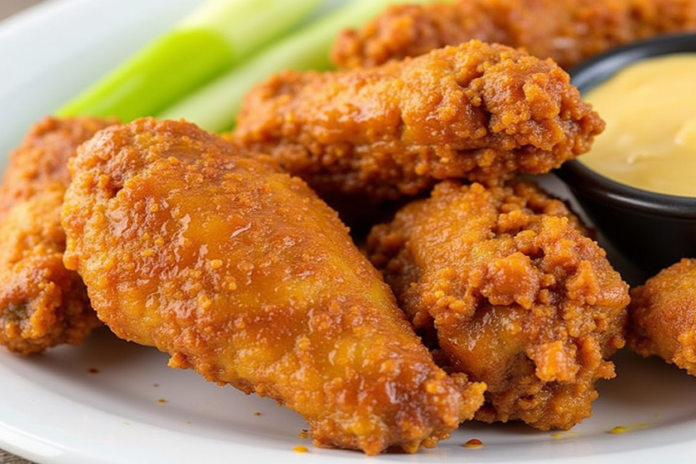Here’s a recipe for Mustard Fried Chicken Wings that combines the zesty flavor of mustard with the crispy texture of fried chicken:
Ingredients:
-
- 2 lbs chicken wings, split into drumettes and flats
- 1 cup whole grain or Dijon mustard
- 2 cups buttermilk
- 2 cups all-purpose flour
- 1 tbsp garlic powder
- 1 tbsp onion powder
- 1 tbsp paprika
- 1 tsp cayenne pepper (optional for heat)
- Salt and pepper to taste
- Oil for frying (vegetable, peanut, or canola oil)
Directions:
Marinate the Chicken:
-
- In a large bowl, mix the mustard and buttermilk until well combined.
- Add the chicken wings to the mixture, ensuring they are fully coated.
- Cover and marinate in the refrigerator for at least 2 hours, or overnight for best results.
Prepare the Breading:
-
- In another large bowl, combine the flour, garlic powder, onion powder, paprika, cayenne pepper, salt, and pepper. Mix well.
Coat the Wings:
-
- Remove the wings from the marinade, letting any excess drip off.
- Dredge each wing in the flour mixture, pressing the flour into the wings to ensure a good coating. Shake off any excess flour.
Frying Preparation:
-
- Heat oil in a deep fryer or large, deep skillet to 350°F. Ensure there’s enough oil to submerge the wings.
Fry the Wings:
-
- Carefully add the wings to the hot oil, working in batches to avoid overcrowding the fryer. This ensures even cooking and crispiness.
- Fry for about 12-15 minutes, turning occasionally, until the wings are golden brown and the internal temperature reaches 165°F.
Drain and Serve:
-
- Use a slotted spoon or spider strainer to remove the wings from the oil, allowing them to drain on paper towels or a wire rack.
Optional Seasoning:
-
- For an extra kick, toss the wings in a mixture of additional mustard and honey or sprinkle with a blend of spices or your favorite hot sauce.
Tips:
-
- For an extra crispy texture, you can do a double breading. After the initial coat of flour, dip the wings back into the buttermilk mixture, then back into the flour.
- Let the wings rest for a few minutes after frying. This allows the juices to redistribute, making them juicier.
This recipe will give you chicken wings with a crispy exterior that’s flavored with mustard, offering a unique twist on traditional fried chicken wings.





Pepsi tasted better in glass bottles
Pepsi tasted better in glass bottles — Some people might consider the taste of Pepsi from a glass bottle as a *perception, but the science might say otherwise. Pepsi and other delightfully fizzy soft drinks actually did taste better.
Taste is much more than just a perception and here’s why:
Glass is inert, meaning it doesn’t react chemically with the contents. This ensures that the taste of Pepsi isn’t altered by the container material, unlike plastic bottles or aluminum cans which can slightly affect the flavor due to trace interactions or the leaching of material compounds into the drink.
Glass bottles are less permeable to gases compared to plastic. This means carbon dioxide, which is responsible for the soda’s fizz, stays in the soda longer, preserving the sensation and flavor associated with freshly opened Pepsi. Over time, plastic bottles allow CO2 to escape, potentially making the soda taste flatter sooner.
Although not directly affecting taste, glass can keep beverages colder for longer if chilled beforehand, and temperature can influence how we perceive taste. A colder Pepsi might taste crisper and more refreshing.
There’s a nostalgic element to drinking from glass bottles, which might enhance the perceived taste experience. The ritual associated with glass bottles, like the sound of opening a bottle or the feel of glass, can psychologically impact how one tastes and enjoys the beverage.
Plastic bottles and cans can sometimes impart a very subtle taste to the beverage. Plastic can transfer acetaldehyde, which might alter the soda’s flavor slightly, and cans have a polymer lining that some claim can absorb or alter flavors. Glass doesn’t have these issues.
Glass bottles are often associated with a time when sodas might have been consumed more promptly after purchase, reducing the time for any potential degradation in taste. Also, the storage conditions for glass bottled sodas in the past might have been different, potentially in cooler, darker places which preserve taste better.
Over all it’s pretty clear that while the formula of Pepsi might not have changed, the container it comes in significantly impacts the drinking experience.
Today’s insights are based on consumer perception and nostalgia as much as they are on the physical properties of glass versus other materials.
The preference for glass might also reflect a broader appreciation for how beverages were consumed in the past, with possibly different recipes or natural ingredients like real sugar, which some argue also tasted better than today’s high fructose corn syrup or artificial sweeteners.
When you look at the science, Pepsi tasted better in glass bottles.